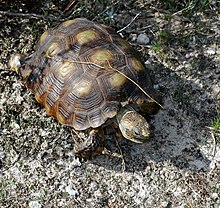Texas tortoise
| Texas tortoise | |
|---|---|

| |
| Scientific classification | |
| Domain: | Eukaryota |
| Kingdom: | Animalia |
| Phylum: | Chordata |
| Class: | Reptilia |
| Order: | Testudines |
| Suborder: | Cryptodira |
| Superfamily: | Testudinoidea |
| Family: | Testudinidae |
| Genus: | Gopherus |
| Species: | G. berlandieri
|
| Binomial name | |
| Gopherus berlandieri (Agassiz, 1857)
| |
| Synonyms[3] | |
| |
The Texas tortoise (Gopherus berlandieri) is a species of tortoise in the family Testudinidae. The species G. berlandieri is one of six species of tortoises that are native to North America.
Geographic range
[edit]G. berlandieri is found from southern Texas southward into the Mexican states of Coahuila, Nuevo León, and Tamaulipas.
Etymology
[edit]The specific epithet, berlandieri, is in honor of naturalist Jean Louis Berlandier, who worked for the Mexican government on one of the first biological surveys of Texas.[1][4] As such, some sources refer to it as Berlandier's tortoise.[4][5]
Biology
[edit]The Texas tortoise, unlike other species of gopher tortoise, is not an adept burrower. Its preferred habitat is dry scrub and grasslands. Succulent plants, a preferred food of the Texas tortoise, are common in these areas. It especially likes the fruit of cacti such as the prickly pear.
Conservation status
[edit]Though considered an animal of low concern by the IUCN Red List, the Texas tortoise is listed as a threatened species in the state of Texas, and thus protected by state law. It is illegal to collect or possess them. The Mexican federal government lists Gopherus berlandieri as A (= Threatened) in Mexico.[6] Likewise, using Environmental Vulnerability Scores, Gopherus berlandieri scored 18, a high vulnerability species on a scale of 0–20, in evaluations of both Tamaulipas and Nuevo Leon herpetofauna.[7][8] In 2018, the IUCN Tortoise and Freshwater Turtle Specialist Group recommended a re-assessment and re-classification of all six Gopherus species.[9] This reclassification would move G. berlandieri from Near Endangered (NE) to Near Threatened (NT).[9]
Gallery
[edit]-
Texas tortoise (Gopherus berlandieri), Val Verde Co, Texas, USA (2005).
-
Gopherus berlandieri, Bee Co. Texas, USA (June 2011).
-
Gopherus berlandieri, Bee Co. Texas, USA (2011).
-
Elongated gular scutes of male, Bee Co. Texas, USA (2011).
-
Texas tortoise (Gopherus berlandieri), northern Tamaulipas, Mexico (2007).
-
Texas tortoise (Gopherus berlandieri), Bee Co. Texas, USA (2023).
- ^ Tortoise & Freshwater Turtle Specialist Group (1996). "Gopherus berlandieri". IUCN Red List of Threatened Species. 1996: e.T9401A12983179. doi:10.2305/IUCN.UK.1996.RLTS.T9401A12983179.en. Retrieved 9 May 2023.
- ^ "Appendices". CITES. Convention on International Trade in Endangered Species of Wild Fauna and Flora. 4 May 2023. Retrieved 9 May 2023.. Note: Protected as a member of the Testudinidae.
- ^ Fritz, Uwe; Havaš, Peter (2007). "Checklist of Chelonians of the World". Vertebrate Zoology. 57 (2): 280–281. doi:10.3897/vz.57.e30895. ISSN 1864-5755.
- ^ a b Beolens, Bo; Watkins, Michael; Grayson, Michael (2011). The Eponym Dictionary of Reptiles. Baltimore: Johns Hopkins University Press. xiii + 296 pp. ISBN 978-1-4214-0135-5. ("Berlandier's Tortoise Gopherus berlandieri ", p. 24).
- ^ Bour, Roger (2016). "Where and when was Jean Louis Berlandier born? Notes on Jean Louis Berlandier. I.". Bibliotheca Herpetologica 12 (1 & 2): 18–40.
- ^ Official Mexican STANDARD NOM-059-SEMARNAT-2010, Environmental Protection-Native species of Mexico of wild flora and fauna-Risk categories and specifications for inclusion, exclusion or change-List of species at risk. STANDARD NOM-059-SEMARNAT-2010 PDF
- ^ Terán-Juárez, S. A., E. García-Padilla, V. Mata-Silva, J. D. Johnson, and L. D. Wilson (2016). "The herpetofauna of Tamaulipas, Mexico: composition, distribution, and conservation". Mesoamerican Herpetology 3: 43–113.
- ^ Nevárez-de los Reyes, M., D. Lazcano, E. García-Padilla, V. Mata-Silva, J. D. Johnson, and L. D. Wilson (2016). "The herpetofauna of Nuevo León, Mexico: composition, distribution, and conservation". Mesoamerican Herpetology 3: 558–638.
- ^ a b Rhodin, Anders G. J.; Stanford, Craig B.; van Dijk, Peter Paul; Eisemberg, Carla; Luiselli, Luca; Mittermeier, Russell A.; Hudson, Rick; Horne, Brian D.; Goode, Eric V.; Kuchling, Gerald; Walde, Andrew (December 2018). "Global Conservation Status of Turtles and Tortoises (Order Testudines)". Chelonian Conservation and Biology. 17 (2): 135–161. doi:10.2744/CCB-1348.1. ISSN 1071-8443. S2CID 91937716.
References
[edit]External links
[edit]- Tortoise & Freshwater Turtle Specialist Group (1996). "Gopherus berlandieri ". The IUCN Red List of Threatened Species. 1996. IUCN: e.T9401A12983179. doi:10.2305/IUCN.UK.1996.RLTS.T9401A12983179.en. Retrieved 9 January 2018.
- Species Gopherus berlandieri at The Reptile Database








